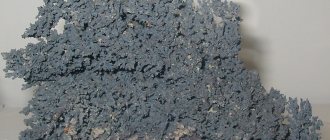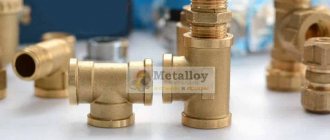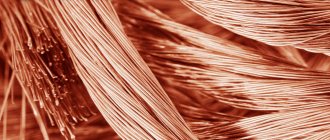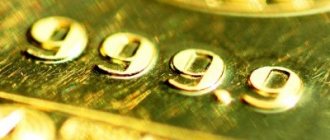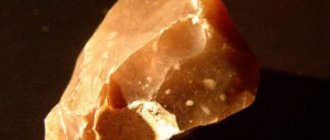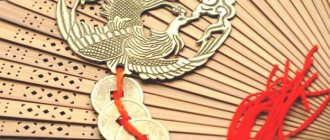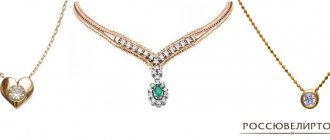Native copper measuring about 4 cm
Copper
- a mineral from the class of native elements. Fe, Ag, Au, As and other elements are found in natural minerals as impurities or forming solid solutions with Cu. The simple substance copper is a ductile transition metal of golden-pink color (pink in the absence of an oxide film). One of the first metals widely mastered by man due to its relative availability for extraction from ore and low melting point. It is one of the seven metals known to man since very ancient times. Copper is an essential element for all higher plants and animals.
- Structure
- Properties
- Reserves and production
- Origin
- Application
- Classification
- Physical properties
- Optical properties
- Crystallographic properties
See also:
Gold
– structure and physical properties
Aluminum
– structure and physical properties
STRUCTURE
Crystal structure of copper
Cubic system, hexaoctahedral type of m3m symmetry, crystal structure – cubic face-centered lattice. The model is a cube of eight atoms in the corners and six atoms located in the center of the faces (6 faces). Each atom of a given crystal lattice has a coordination number of 12. Native copper occurs in the form of plates, spongy and solid masses, thread-like and wire-like aggregates, as well as crystals, complex twins, skeletal crystals and dendrites. The surface is often covered with films of “copper green” (malachite), “copper blue” (azurite), copper phosphates and other products of its secondary alteration.
Where is copper used?
This metal is popular both in its pure form and in combination with other elements. Copper and its alloys are used to produce copper wire, copper pipes, roofing, kitchen utensils, jewelry, arts and crafts, coins, air conditioners, various household appliances, and glass dyes. Since copper is essential for the normal functioning of living organisms, it is also used to make food supplements. Let us consider the spheres and areas of application of copper and its alloys in more detail.
PROPERTIES
Native copper crystals, Lake Superior, Kinawee County, Michigan, USA. Size 12 x 8.5 cm
Copper is a golden-pink ductile metal; in air it quickly becomes covered with an oxide film, which gives it a characteristic intense yellowish-red hue. Thin films of copper have a greenish-blue color when exposed to light.
Along with osmium, cesium and gold, copper is one of the four metals that have a distinct coloration that is different from the gray or silver of other metals. This color tint is explained by the presence of electronic transitions between the filled third and half-empty fourth atomic orbitals: the energy difference between them corresponds to the wavelength of orange light. The same mechanism is responsible for the characteristic color of gold.
Copper has high thermal and electrical conductivity (it ranks second in electrical conductivity among metals after silver). Specific electrical conductivity at 20 °C: 55.5-58 MS/m. Copper has a relatively large temperature coefficient of resistance: 0.4%/°C and is weakly dependent on temperature over a wide temperature range. Copper is diamagnetic.
There are a number of copper alloys: brass - with zinc, bronze - with tin and other elements, cupronickel - with nickel and others.
Alloys
Pure copper is not always used in industry. To change the technical characteristics of non-ferrous metal, various components are added to it. The result is alloys that have a copper base. The most common:
- Bronze - Made by adding tin.
- Brass is made from a copper base to which zinc is added.
These are not all compounds where copper is the main component.
Bronze figurine
RESERVES AND PRODUCTION
Copper specimen, 13.6 cm. Kinawi Peninsula, Michigan, USA
The average copper content in the earth's crust (clarke) is (4.7-5.5) 10−3% (by mass). In sea and river water the copper content is much lower: 3·10−7% and 10−7% (by weight), respectively. Most copper ore is mined by open pit mining. The copper content in the ore ranges from 0.3 to 1.0%. World reserves in 2000 were, according to experts, 954 million tons, of which 687 million tons were proven reserves; Russia accounted for 3.2% of total and 3.1% of confirmed world reserves. Thus, at the current rate of consumption, copper reserves will last approximately 60 years. Copper is obtained from copper ores and minerals. The main methods for obtaining copper are pyrometallurgy, hydrometallurgy and electrolysis. The pyrometallurgical method involves obtaining copper from sulfide ores, for example, chalcopyrite CuFeS2. The hydrometallurgical method involves dissolving copper minerals in dilute sulfuric acid or ammonia solution; From the resulting solutions, copper is replaced by metallic iron.
History of discovery
The most ancient copper products were found in the territory of modern Turkey. They were located in the ruins of the settlement of Çatalhöyük. After the Stone Age came the Copper Age. Scientists in the 20th century were able to prove that with the help of tools made of copper, materials can be processed faster.
Alloys with tin, called bronze, were made from copper. They were used to create jewelry, tools, and weapons. When bronze gained great popularity, the Bronze Age began, which replaced the Copper Age.
The first large mines were found in Cyprus. They were developed around 3000 BC. e. In Russia, the oldest mines date back to 2000 BC. e.
Industrial smelting of copper ingots was developed in the 13th–14th centuries. In Moscow in the 15th century, the Cannon Yard was founded, which produced guns and ammunition from bronze.
ORIGIN
Small nugget of copper
Typically, native copper is formed in the oxidation zone of some copper sulfide deposits in association with calcite, native silver, cuprite, malachite, azurite, brochantite and other minerals. The masses of individual clusters of native copper reach 400 tons. Large industrial deposits of native copper, along with other copper-containing minerals, are formed when volcanic rocks (diabases, melaphyres) are exposed to hydrothermal solutions, volcanic vapors and gases enriched in volatile copper compounds (for example, the Lake Superior deposit, USA). Native copper is also found in sedimentary rocks, mainly in cuprous sandstones and shales. The most famous deposits of native copper are the Turin mines (Urals), Dzhezkazgan (Kazakhstan), in the USA (on the Keweenaw Peninsula, in the states of Arizona and Utah).
Processing methods
Mechanical processing can be done by:
- Broaches. A technological process used in the manufacture of wires and wires of different diameters. An extruder mechanism is used for production.
- Rolling. Technological process for the production of flat copper products. The workpieces are rolled through a machine with movable rollers.
- Polishing. To give copper products a characteristic metallic shine, felt and fabric discs are used.
- Grinding. It is used to remove a certain layer of metal, clean it from plaque and dirt. Grinding is carried out using abrasives.
The turning method of processing copper blanks also deserves attention. It is used to manufacture washers, studs, fittings, bushings, and flanges.
Copper is a sought-after non-ferrous metal with good physical and chemical properties. The metal is suitable for making jewelry, parts of industrial machines, household appliances, and radio components.
APPLICATION
Copper bracelets
Due to its low resistivity, copper is widely used in electrical engineering for the manufacture of power cables, wires or other conductors, for example, in printed circuit wiring. Copper wires, in turn, are also used in the windings of energy-saving electric drives and power transformers. Another useful quality of copper is its high thermal conductivity. This allows it to be used in various heat removal devices and heat exchangers, which include well-known radiators for cooling, air conditioning and heating. Alloys using copper are widely used in various fields of technology, the most widespread of which are the above-mentioned bronze and brass. Both alloys are general names for a whole family of materials, which in addition to tin and zinc may include nickel, bismuth and other metals. In jewelry, alloys of copper and gold are often used to increase the resistance of products to deformation and abrasion, since pure gold is a very soft metal and is not resistant to these mechanical influences. The predicted new mass use of copper promises to be its use as bactericidal surfaces in medical institutions to reduce intra-hospital bacterial transfer: doors, handles, water stop valves, railings, bed rails, table tops - all surfaces touched by the human hand.
Copper – Cu
| Molecular weight | 63.55 g/mol |
| origin of name | From the Greek “Kyprium”, that is, “Cypriot metal”, after the name of the island of Cyprus |
| IMA status | valid, first described before 1959 (before IMA) |
Copper
(Cu from Latin Cuprum) is an element of the eleventh group of the fourth period (a side subgroup of the first group) of the periodic system of chemical elements of D. I. Mendeleev, with atomic number 29. The simple substance copper is a plastic transition metal of golden-pink color (pink color when absence of oxide film). It has been widely used by humans for a long time. Copper coin (photo)
History
Copper is one of the first metals well mastered by man due to its availability from ore and low melting point. This metal is found in nature in native form more often than gold, silver and iron. Some of the most ancient copper products, as well as slag - evidence of its smelting from ores - were found in Turkey, during excavations of the settlement of Çatalhöyük. The Copper Age, when copper objects became widespread, follows the Stone Age in world history. Experimental studies by S. A. Semenov and his colleagues showed that, despite the softness of copper, copper tools, compared to stone ones, provide a significant advantage in the speed of cutting, planing, drilling and sawing wood, and processing bone takes approximately the same time as for stone tools
In ancient times, copper was also used in the form of an alloy with tin - bronze - for the manufacture of weapons, etc., the Bronze Age replaced the Copper Age. An alloy of copper and tin (bronze) was produced for the first time in 3000 BC. e. in the Middle East. Bronze attracted people because of its strength and good malleability, which made it suitable for making labor and hunting tools, dishes, and jewelry. All these items are found in archaeological excavations. The Bronze Age regarding tools was replaced by the Iron Age.
Copper was originally mined from malachite ore rather than sulfide ore, as it does not require pre-roasting. To do this, a mixture of ore and coal was placed in a clay vessel, the vessel was placed in a small pit, and the mixture was set on fire. The released carbon monoxide reduced malachite to free copper:
In Cyprus, already in the 3rd millennium BC there were copper mines and copper smelting was carried out.
Copper mines appeared on the territory of Russia and neighboring countries two millennia BC. e. Their remains are found in the Urals (the most famous deposit is Kargaly), in Transcaucasia, in Siberia, Altai, and in Ukraine.
In the XIII-XIV centuries. mastered industrial copper smelting. In Moscow in the 15th century. The Cannon Yard was founded, where guns of various calibers were cast from bronze. A lot of copper was used to make bells. Such works of casting art as the Tsar Cannon (1586), the Tsar Bell (1735), the Bronze Horseman (1782) were cast from bronze, and a statue of the Big Buddha was cast in Japan (Todai-ji Temple) ( 752).
With the discovery of electricity in the 18th-19th centuries. large volumes of copper began to be used for the production of wires and other related products. And although in the 20th century. wires often began to be made of aluminum; copper has not lost its importance in electrical engineering.
Origin of the name copper
The Latin name for copper Cuprum (ancient Aes cuprium, Aes cyprium) comes from the name of the island of Cyprus, where there was a rich deposit.
Strabo calls copper chalkos, from the name of the city of Chalkis on Euboea. From this word came many ancient Greek names for copper and bronze objects, blacksmithing, blacksmithing and casting. The second Latin name for copper Aes (Sanskrit ayas, Gothic aiz, German erz, English ore) means ore or mine.
The words copper and copper are found in the most ancient Russian literary monuments. Slavic *mědь “copper” does not have a clear etymology, perhaps an original word. V.I. Abaev assumed the origin of the word from the name of the country Media: *Copper from Ir. Māda - through the Greek. Μηδία[8]. According to the etymology of M. Vasmer, the word “copper” is related to ancient German. smid “blacksmith”, smîda “metal”.
Copper was designated by the alchemical symbol “♀” - “mirror of Venus”, and sometimes copper itself was also called “Venus” by alchemists. This is due to the fact that the goddess of beauty, Venus (Aphrodite), was the goddess of Cyprus, and mirrors were made from copper. This symbol of Venus was also depicted on the brand of the Polevsky copper smelter, it was used to brand Polevsky copper from 1735 to 1759, and is depicted on the modern coat of arms of the city of Polevskoy. Polevsky’s Gumeshevsky mine, the largest copper ore deposit of the Russian Empire in the Middle Urals in the 18th-19th centuries, is associated with a famous character in P. P. Bazhov’s fairy tales - the Mistress of the Copper Mountain, the patroness of the mining of malachite and copper. According to one hypothesis, she is the image of the goddess Venus refracted by the popular consciousness.
Copper in nature
The average copper content in the earth's crust (clarke) is (4.7-5.5) 10−3% (by mass). In sea and river water the copper content is much lower: 3·10−7% and 10−7% (by weight), respectively.
Copper occurs in nature both in compounds and in native form. Of industrial importance are chalcopyrite CuFeS2, also known as copper pyrite, chalcocite Cu2S and bornite Cu5FeS4. Together with them, other copper minerals are also found: covellite CuS, cuprite Cu2O, azurite Cu3(CO3)2(OH)2, malachite Cu2CO3(OH)2. Sometimes copper is found in native form; the mass of individual clusters can reach 400 tons. Copper sulfides are formed mainly in medium-temperature hydrothermal veins. Copper deposits are also often found in sedimentary rocks - cuprous sandstones and shales. The most famous deposits of this type are Udokan in the Trans-Baikal Territory, Zhezkazgan in Kazakhstan, the copper belt of Central Africa and Mansfeld in Germany. The other richest copper deposits are in Chile (Escondida and Colhausi) and the USA (Morenci).
Most copper ore is mined by open pit mining. The copper content in the ore ranges from 0.3 to 1.0%.
Physical properties of copper
Copper is a golden-pink ductile metal; in air it quickly becomes covered with an oxide film, which gives it a characteristic intense yellowish-red hue. Thin films of copper have a greenish-blue color when exposed to light.
Along with osmium, cesium and gold, copper is one of the four metals that have a distinct coloration that is different from the gray or silver of other metals. This color tint is explained by the presence of electronic transitions between the filled third and half-empty fourth atomic orbitals: the energy difference between them corresponds to the wavelength of orange light. The same mechanism is responsible for the characteristic color of gold.
Copper forms a cubic face-centered lattice, space group F m3m, a = 0.36150 nm, Z = 4.
Copper has high thermal and electrical conductivity (it ranks second in electrical conductivity among metals after silver). Specific electrical conductivity at 20 °C: 55.5-58 MS/m. Copper has a relatively large temperature coefficient of resistance: 0.4%/°C and is weakly dependent on temperature over a wide temperature range. Copper is diamagnetic.
There are a number of copper alloys: brass - with zinc, bronze - with tin and other elements, cupronickel - with nickel and others.
Atomic density of copper (N0) = 8.52 * 10 28 (atom/m³).
Application of copper
in electrical engineering
Due to its low resistivity (second only to silver, resistivity at 20 °C: 0.01724-0.0180 μOhm m/), copper is widely used in electrical engineering for the manufacture of power and other cables, wires or other conductors, for example, in printed circuit wiring. Copper wires, in turn, are also used in the windings of electric drives (household: electric motors) and power transformers. For these purposes, the metal must be very pure: impurities sharply reduce electrical conductivity. For example, the presence of 0.02% aluminum in copper reduces its electrical conductivity by almost 10%.
Heat exchange
Cooling system made of copper on heat pipes in a laptop Another useful quality of copper is its high thermal conductivity. This allows it to be used in various heat sink devices, heat exchangers, which include well-known cooling, air conditioning and heating radiators, computer coolers, and heat pipes.
For pipe production
Due to their high mechanical strength and suitability for machining, copper seamless round pipes are widely used for transporting liquids and gases: in internal water supply systems, heating systems, gas supply systems, air conditioning systems and refrigeration units. In a number of countries, copper pipes are the main material used for these purposes: in France, Great Britain and Australia for gas supply to buildings, in Great Britain, USA, Sweden and Hong Kong for water supply, in Great Britain and Sweden for heating.
Copper rods (photo)
Copper pipes (photo)
In Russia, the production of water and gas pipes from copper is standardized by the national standard GOST R 52318-2005, and the application in this capacity by the federal Code of Rules SP 40-108-2004. In addition, pipelines made of copper and copper alloys are widely used in the shipbuilding and energy industries to transport liquids and steam.
Copper alloys
Alloys using copper are widely used in various fields of technology, the most widespread of which are the above-mentioned bronze and brass. Both alloys are general names for a whole family of materials, which, in addition to tin and zinc, may include nickel, bismuth and other metals. For example, the composition of gun bronze, used for the manufacture of artillery pieces until the 19th century, includes all three main metals - copper, tin, zinc; the recipe changed depending on the time and place of manufacture of the weapon. A large amount of brass is used for the manufacture of artillery ammunition casings and weapon casings, due to its manufacturability and high ductility. For machine parts, alloys of copper with zinc, tin, aluminum, silicon, etc. (rather than pure copper) are used because of their greater strength: 30-40 kgf/mm² for alloys and 25-29 kgf/mm² for technically pure copper. Copper alloys (except beryllium bronze and some aluminum bronzes) do not change their mechanical properties during heat treatment, and their mechanical properties and wear resistance are determined only by the chemical composition and its effect on the structure. Modulus of elasticity of copper alloys (900-12000 kgf/mm², lower than that of steel). The main advantage of copper alloys is their low coefficient of friction (which makes them especially rational for use in sliding pairs), combined for many alloys with high ductility and good resistance to corrosion in a number of aggressive environments (copper-nickel alloys and aluminum bronzes) and good electrical conductivity. The magnitude of the coefficient of friction is almost the same for all copper alloys, while the mechanical properties and wear resistance, as well as behavior under corrosion conditions, depend on the composition of the alloys, and therefore on the structure. Strength is higher in two-phase alloys, and ductility is higher in single-phase alloys. Copper-nickel alloy (cupronickel) is used for minting small change coins. Copper-nickel alloys, including the so-called “Admiralty” alloy, are widely used in shipbuilding (turbine exhaust steam condenser tubes cooled by sea water) and applications related to the possibility of aggressive action of sea water due to their high corrosion resistance. Copper is an important component of hard solders - alloys with a melting point of 590-880 ° C, which have good adhesion to most metals, and are used for durable connections of a variety of metal parts, especially dissimilar metals, from pipeline fittings to liquid rocket engines.
Alloys in which copper is significant
A duralumin part of the Hindenburg airship (LZ 129) damaged by fire. Dural (duralumin) is defined as an alloy of aluminum and copper (copper in duralumin is 4.4%).
Jewelry alloys
In jewelry, alloys of copper and gold are often used to increase the resistance of products to deformation and abrasion, since pure gold is a very soft metal and is not resistant to mechanical stress.
Copper connections
Copper oxides are used to produce yttrium-barium-copper oxide (cuprate) YBa2Cu3O7-δ, which is the basis for the production of high-temperature superconductors. Copper is used to produce copper oxide galvanic cells and batteries.
Other Applications
Copper is the most widely used acetylene polymerization catalyst. Due to the fact that copper is a catalyst for the polymerization of acetylene (forms compounds of copper with acetylene), copper pipelines for transporting acetylene can only be used if the copper content in the alloy of the pipe material is no more than 64%.
Copper is widely used in architecture. Roofs and facades made of thin sheet copper, due to the auto-attenuation of the corrosion process of the copper sheet, serve trouble-free for 100-150 years. In Russia, the use of copper sheets for roofs and facades is regulated by the federal Code of Rules SP 31-116-2006.
The predicted new mass use of copper promises to be its use as bactericidal surfaces in medical institutions to reduce intra-hospital bacterial transfer: doors, handles, water stop valves, railings, bed rails, table tops - all surfaces touched by the human hand.
Copper vapor is used as a working fluid in copper vapor lasers at lasing wavelengths of 510 and 578 nm.
Copper production and mining.
World copper production in 2000 was about 15 million tons, and in 2004 - about 14 million tons. World reserves in 2000 were, according to experts, 954 million tons, of which 687 million tons were proven reserves; Russia accounted for 3.2% of total and 3.1% of confirmed world reserves. Thus, at the current rate of consumption, copper reserves will last approximately 60 years.
Production of refined copper in Russia in 2006 amounted to 881.2 thousand tons, consumption - 591.4 thousand tons. The main copper producers in Russia were:
Company thousand tons % Norilsk Nickel 425 45% Uralelectromed 351 37% Russian Copper Company 166 18%
In 2009, Metalloinvest Holding joined these copper producers in Russia, purchasing the rights to develop the new Udokanskoye copper deposit. World copper production in 2007 was 15.4 million tons, and in 2008 - 15.7 million tons.
The leaders in production were:
Chile (5.560 million tons in 2007 and 5.600 million tons in 2008), USA (1.170/1.310), Peru (1.190/1.220), China (0.946/1.000), Australia (0.870/0.850), Russia (0.740 /0.750), Indonesia (0.797/0.650), Canada (0.589/0.590), Zambia (0.520/0.560), Kazakhstan (0.407/0.460), Poland (0.452/0.430), Mexico (0.347/0.270). In terms of global production and consumption, copper ranks third after iron and aluminum.
The world's explored copper reserves at the end of 2008 amounted to 1 billion tons, of which 550 million tons were confirmed. Moreover, it is estimated that the global world reserves on land amount to 3 billion tons, and deep-sea resources are estimated at 700 million tons.
Copper powder (photo)
Modern mining methods
More than 170 minerals containing copper are now known, but only 14-15 of them are of industrial importance. This is chalcopyrite (also known as copper pyrite), malachite, and native copper is also found. Copper ores often contain molybdenum, nickel, lead, cobalt as impurities, and less commonly gold and silver. Typically, copper ores are beneficiated in factories before being sent to copper smelters. Kazakhstan, the USA, Chile, Canada, and African countries are rich in copper - Zaire, Zambia, South Africa. Escondida is the world's largest copper ore quarry (located in Chile). Depending on the depth of occurrence, ore is mined using open or closed methods.
90% of primary copper is obtained by pyrometallurgical method, 10% by hydrometallurgical method. The hydrometallurgical method is the production of copper by dissolving it in a weak solution of sulfuric acid and subsequent separation of metallic (blister) copper from the solution. The pyrometallurgical method consists of several stages: enrichment, roasting, smelting for matte, purging in a converter, refining.
To enrich copper ores, the flotation method is used (based on the use of different wettability of copper-containing particles and waste rock), which allows one to obtain copper concentrate containing from 10 to 35% copper.
Copper ores and concentrates with high sulfur content are subjected to oxidative roasting. In the process of heating the concentrate or ore to 700-800 °C in the presence of atmospheric oxygen, sulfides are oxidized and the sulfur content is reduced by almost half of the original. Only poor concentrates (with a copper content of 8 to 25%) are fired, and rich concentrates (from 25 to 35% copper) are melted without firing.
After roasting, the ore and copper concentrate are smelted into matte, which is an alloy containing copper and iron sulfides. Matte contains from 30 to 50% copper, 20-40% iron, 22-25% sulfur, in addition, matte contains impurities of nickel, zinc, lead, gold, and silver. Most often, smelting is carried out in fiery reverberatory furnaces. The temperature in the melting zone is 1450 °C.
In order to oxidize sulfides and iron, the resulting copper matte is subjected to blowing with compressed air in horizontal converters with side blast. The resulting oxides are converted into slag. The temperature in the converter is 1200–1300 °C. Interestingly, heat is released in the converter due to chemical reactions, without fuel supply. Thus, the converter produces blister copper containing 98.4–99.4% copper, 0.01–0.04% iron, 0.02–0.1% sulfur and a small amount of nickel, tin, antimony, silver, gold. This copper is poured into a ladle and poured into steel molds or a casting machine.
Next, to remove harmful impurities, blister copper is refined (fire refining and then electrolytic refining are carried out). The essence of fire refining of blister copper is the oxidation of impurities, removing them with gases and converting them into slag. After fire refining, copper with a purity of 99.0–99.7% is obtained. It is poured into molds and ingots are obtained for further smelting of alloys (bronze and brass) or ingots for electrolytic refining.
Electrolytic refining is carried out to obtain pure copper (99.95%). Electrolysis is carried out in baths where the anode is made of fire-refined copper, and the cathode is made of thin sheets of pure copper. The electrolyte is a solution of sulfuric acid with copper sulfate. During electrolysis, the concentration of sulfuric acid increases. When a direct current is passed, the anode dissolves, the copper goes into solution, and, cleaned of impurities, is deposited on the cathodes. Impurities settle to the bottom of the bath in the form of sludge, which is processed to extract valuable metals. When receiving 1000 tons of electrolytic copper, you can get up to 3 kg of silver and 200 g of gold. The cathodes are unloaded after 5-12 days, when their weight reaches 60 to 90 kg. They are thoroughly washed and then melted in electric furnaces.
Copper granules (photo)
PHYSICAL PROPERTIES
| Mineral color | copper-red, fading to black or green in air |
| Stroke color | copper red |
| Transparency | opaque |
| Shine | metal |
| Cleavage | No |
| Hardness (Mohs scale) | 2,5-3 |
| Strength | malleable |
| Kink | jagged |
| Density (measured) | 8.94 – 8.95 g/cm3 |
| Radioactivity (GRapi) | 0 |
| Magnetism | diamagnetic |
Combination of copper with other colors and textures
The color palette of copper includes many shades and nuances - from rich red to soft pink. Depending on the time of day and lighting, copper surfaces can glow red, orange or yellow, which must be taken into account when combining copper with other materials, textures and colors and creating an overall color composition.
The copper tone in the interior harmonizes best with muted natural shades: black, white, brown, deep blue, olive, emerald, graphite, dark green and turquoise. Such combinations are especially appropriate for apartments decorated in a fashionable ecological or ethnic style.
Finishing with a terracotta sheen will emphasize the impressiveness of furniture made of dark wood. For light-colored sets, framing with copper mosaic or sheets of golden-honey tone will be more effective.
The juxtaposition of a metal apron with weightless tabletops made of transparent glass will fit advantageously into deliberately brutal lofts or high-tech rooms.
Luxurious historical settings such as Art Deco or Neoclassical will suit a combination of copper with sophisticated crystal stained glass windows.
Artificially oxidized copper in the setting will organically complement industrial locations. And even vintage copper frying pans simply hung in a row against a tiled wall will add the necessary retro notes to the interior.
CRYSTALLOGRAPHIC PROPERTIES
| Point group | m3m (4/m 3 2/m) – hexoctahedral |
| Space group | Fm3m (F4/m 3 2/m) |
| singonia | cubic |
| Cell Options | a = 3.615Å |
| Morphology | cubes, dodecahedrons and tetrahexahedrons; rarely octahedra and complex combinations; thread-like, tree-like |
| Twinning | {111} twins according to the spinel law |
Copper roofing
The beautiful color that is characteristic of copper (see photo), as well as its exceptional corrosion resistance, was the reason that many years ago it began to be used as a roofing material. For a long time, copper in this capacity was inferior to cheaper steel and aluminum, but now architects and designers have again paid attention to this unique metal in all respects.
A copper roof with a luxurious color not only looks attractive from an aesthetic point of view and can serve its owners for decades, but is also able to successfully withstand significant mechanical, temperature and any other influences. Houses covered with roofing made of this metal look stylish and presentable.
Copper roofing
Use of copper in medicine
Traditional medicine considers copper to be a very important element of human life. In the body, this substance is contained in an amount of 2 * 10-4% of the total mass. Every day a person consumes up to 60 mg of copper with food, of which approximately 2 mg is absorbed, which is the necessary norm for a healthy body. Copper plays an important role in the biosynthesis of hemoglobin, in maintaining the levels of sugar, cholesterol and uric acid. Copper is necessary for the normal functioning of the cardiovascular system, brain, and digestive tract. In case of its deficiency, the following develops:
- anemia;
Use of copper in medicine - osteoporosis;
- glaucoma;
- psoriasis;
- bronchial asthma;
- neuritis;
- atrophy of the heart muscle;
- fatigue;
- weight loss;
- accumulation of cholesterol.
Use of copper in medicine:
- For the treatment of acute deficiency, medications containing this microelement are used;
- in therapy - the use of metal applications or bracelets.
The largest amount of microelement is found in foods such as:
- Champignon;
- potato;
- Cod liver;
- whole grain;
- oysters and cuttlefish.
At the same time, excess copper in the body, when its amount exceeds 250 mg, leads to intoxication and disruption of the liver, the development of Wilson's disease, and anemia.
Note:
205* The empirical radius of the copper atom according to [1] and [3] is 128 pm.
206* Covalent radius of copper according to [1] and [3] is 132±4 pm and 117 pm, respectively.
401* The density of copper according to [3] is 8.92 g/cm3 (at 0 °C and other standard conditions, the state of the substance is a solid).
402* The melting point of copper according to [3] and [4] is 1083.4 °C (1356.55 K, 1982.12 °F) and 1083 °C (1356.15 K, 1981.4 °F), respectively.
403* The boiling point of copper according to [3] and [4] is 2567 °C (2840.15 K, 4652.6 °F) and 2543 °C (2816.15 K, 4609.4 °F), respectively.
407* The specific heat of fusion (enthalpy of fusion ΔHmelt) of copper according to [3] and [4] is 13.01 kJ/mol and 13 kJ/mol, respectively.
408* The specific heat of evaporation (enthalpy of boiling ΔHboiling) of copper according to [3] and [4] is 304.6 kJ/mol and 302 kJ/mol, respectively.
